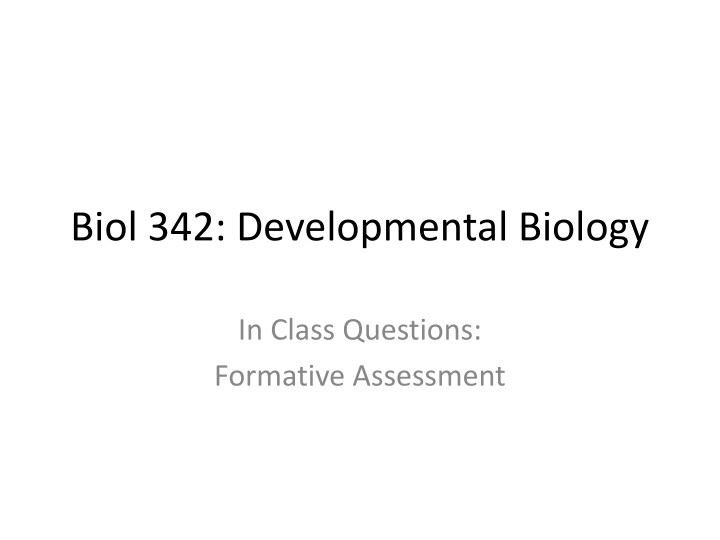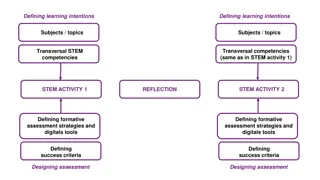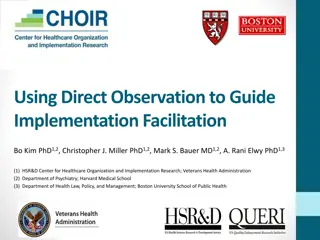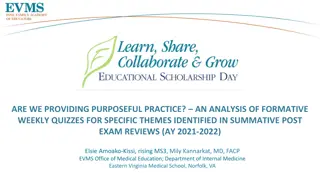
Developmental Biology Class Questions: Formative Assessment Insights
Explore formative assessment questions on developmental differences between protostomes and deuterostomes, genes important in development, the Ur-bilaterian ancestor, cell fate in embryos, cell behavior theories, and transgenic fish creation in zebrafish embryos.
Uploaded on | 0 Views
Download Presentation

Please find below an Image/Link to download the presentation.
The content on the website is provided AS IS for your information and personal use only. It may not be sold, licensed, or shared on other websites without obtaining consent from the author. If you encounter any issues during the download, it is possible that the publisher has removed the file from their server.
You are allowed to download the files provided on this website for personal or commercial use, subject to the condition that they are used lawfully. All files are the property of their respective owners.
The content on the website is provided AS IS for your information and personal use only. It may not be sold, licensed, or shared on other websites without obtaining consent from the author.
E N D
Presentation Transcript
Biol 342: Developmental Biology In Class Questions: Formative Assessment
The major developmental difference between protostomes and deuterostomes is in .? A. the presence/absence of an exoskeleton. B. the number of germ layers formed. C. the order in which digestive tract openings form. D. the number of HOX gene clusters E. the absence/presence of an archenteron
What is meant by toolkits of genes that are important to developmental processes? After answering, try to come up with an example. A. Gene families, each member of which encodes a protein with a conserved structural motif or domain B. Genes that are shared between species members within a single genus C. Multiple genes that are conserved in evolutionarily diverged organisms and that encode proteins involved in the same developmental process. D. Multiple genes that encode proteins involved in different developmental processes in a single organism
In deducing what the ur-bilaterian ancestor of both protostomes and deuterostomes was like, determining which of the following might be most relevant? A. the structural and functional conservation of developmentally important genes in organisms of both lineages. B. the number of HOX clusters in organisms of both lineages. C. the absence/presence of a notochord in organisms of both lineages. D. the absence/presence of an immune system in organisms of both lineages.
Fate mapping in a frog species shows that cells in a specific region of a blastula stage embryo always give rise to the blood cells. Based on this information, these cells in the blastula embryo are best described as: A. specified B. committed C. determined D. differentiated E. none of the above
What theory/process best fits the idea of cells behaving as a fluid? A.Fluid Dynamics Model B.Differential Adhesion Hypothesis C.Gastrulation D.Epiboly E.Anoikis
You wish to visualize muscle formation in live zebrafish embryos, so you decide to make transgenic fish. To do this, you use a piece of DNA 5 to the start of transcription of a muscle-specific gene. This DNA fragment should contain the ______ of the muscle-specific gene, and should be fused to the coding region of the ______ gene prior to transgenic fish construction, in order to visualize expression of the gene in muscle cells. A. reporter; LacZ B. 5 control region; LacZ C. 5 control region; GFP D. reporter; LacZ E. 5 control region; myosin
Which of the following would be the best way to follow the fate of neural crest cells in developing vertebrate embryos? A. performing in situ hybridization to detect neural crest specific transcripts B. making chick-quail chimeras C. electron microscopy D. labeling cells with a fluorescent dye E. injecting double stranded RNA
Which paper best demonstrated pluripotency of the nucleus? A.Lee, et al., 2008. B.Wilmut, et al., 1996. C.Yamanaka, et al., 2006. D.Foty, et al., 1996.
Which paper best demonstrated pluripotency of the nucleus? A. Lee, et al., 2008. -Autocrine VEGF signaling is required for vascular homeostasis B. Wilmut, et al., 1996. -Sheep cloned by nuclear transfer from a cultured cell line C. Yamanaka, et al., 2006 - Induction of Pluripotent Stem Cells from Mouse Embryonic and Adult Fibroblast Cultures by Defined Factors D. Foty, et al., 1996. - The differential adhesion hypothesis: a direct evaluation
Which of the following might be expected to happen to a neuron-specific gene in the lateral mesoderm of a mouse embryo? A. it would be translationally silenced via miRNA expression (RNAi) B. it would be translationally activated via miRNA expression (RNAi) C. it s promoter region (DNA) would become acetylated D. it would be associated with nucleosomes that contain acetylated histones E. none of the above
Identify the following organisms. Which is the most ideal model system for studying germ layer specification? Neural Crest Cell contribution? Stem cells? A. Caenorhabditis elegans B. Drosophila melanogaster C. Mus musculus D. Homo Sapiens E. Gallus gallus
Which of the following processes can be regulated by non coding RNA? A. chromatin packaging of target genes B. translation of target genes C. vertebrate skeletal muscle differentiation D. embryonic stem cell fate E. All of the above
You are conducting a study of a gene that is expressed in the pancreas in developing mouse embryos. You use in situ hybridization with a probe from the protein coding region of the gene, and discover uniform expression in the entire pancreas at a particular developmental stage. You isolate a ~2 kb fragment of DNA upstream of the transcription start site of the gene, and fuse this to a GFP reporter. The combined construct is used in transgenesis experiments to investigate the gene s expression in other endodermal tissues. Before examining other tissues, you first want to make sure that GFP expression mirrors your in situ data. To your surprise (and chagrin), when you examine GFP expression in the developing pancreas, you observe a region of pancreatic tissue that does notexpress GFP. You attribute this to A. a modular enhancer is missing from your ~2kb upstream fragment B. RNAi caused by your transgene C. X chromosome inactivation = mosaic expression of transgene D. an artifact caused by the genomic insertion position of the transgene E. none of the above
The correct order of segmentation gene expression in insects is A. maternal genes >> gap genes >> segment polarity genes >> pair rule genes B. pair rule genes >> gap genes >> segment polarity genes >> maternal genes C. maternal genes >> gap genes >> pair rule genes >> segment polarity genes D. maternal genes >> pair rule genes >> gap genes >> segment polarity genes E. none of the above
Which of the following proteins is important in dorsal mesoderm migration during amphibian gastrulation? A. sonic hedgehog B. Drosha C. collagen D. fibronectin E. N-cadherin
Which of the following Extracellular Matrix (ECM) proteins is important in dorsal mesoderm migration during amphibian gastrulation? A. sonic hedgehog B. Drosha C. collagen D. fibronectin E. N-cadherin
The blastopore of amphibian embryos is analogous to the... A. the primitive streak of mammalian and avian embryos B. the blastocoel of avian and mammalian embryos C. the trophectoderm of mammalian embryos E. none of the above
The formation of the gray crescent due to cortical rotation in certain amphibian embryos occurs: A. at the future ventral side of the embryo B. at the transition between cleavage and gastrulation during C. prior to the first zygotic cleavage D. at the vegetal pole E. at the animal pole
The archenteron is a precursor to... A. the somites B. the gut cavity C. the mouth D. the nervous system E. none of the above
The somites of vertebrate embryos are of __________ origin and contribute to __________ A. ectodermal; neural tissue & dermis B. mesodermal; muscles & dermis & vertebrae C. endodermal; gut lining & neural crest D. mesodermal; heart & kidney
In order to determine the location of expression of a gene of interest during development, the best technique to use would be: A.Conditional Knock-out mouse B. In situ hybridization C. Southern Blot D.Gene sequencing E. Western Blot
Which of the following types of stem cells has the most potency? A.iPS cells B.Neural Crest Cells C.hES cells D.SCNT cells E.HSCs
Which of the following does NOT correctly describe a HOX gene? A. A HOX gene is found in a cluster with other HOX genes in vertebrates and invertebrates B. A HOX gene can determine a cell s A/P identity (fate) C. A HOX gene always encodes a transcription factor D. A HOX gene can be regulated by non coding RNA E. A HOX gene can be involved in proximal-distal identity in developing limb buds (vertebrates).
In the Rhodes, et al. paper (2008) concerning HSC development in the placenta, the best explanation for the rationale of the transgenic models used can be described by: A. A need to knock-out a gene of interest in HSCs. B. A need to visualize a process. C. A need to determine the site of origin D. A need to determine the effect of the circulatory system on blood formation E. A need to determine mechanism of embryonic lethality
Mutations in which gene was found to be heterozygous lethal? A.beta-1 integrin B.sox-4 C.wnt D.shh E.vegf
Which of the following describes sonic hedgehog? A. A protein with orthologs in both vertebrates and invertebrates B. A secreted signaling molecule C. A protein that controls anterior-posterior development in vertebrate limb buds D. A protein that is secreted by vertebrate notochords E. A HOX protein
The bicoid protein in early Drosophila embryos is found: A. in a concentration gradient, with highest concentrations at the posterior pole B. evenly distributed C. in a concentration gradient, with highest concentrations at the anterior pole D. in the middle of the embryo E. nowhere
A group of cells is removed from its normal position in an early embryo and placed at an abnormal location in a recipient embryo. This explant is observed to develop into tissue that it would have had it not been transplanted. At the time of transplantation, the cells that were transplanted were: A. determined B. differentiated C. uncommitted D. transdetermined E. none of the above
Both figures below show the distribution of a protein encoded by gene X in Drosophila. Gene X s protein product is distributed in a striped pattern in a wild-type (x+/x+; z+/z+) cellular blastoderm embryo (Figure 1). Another gene, Z, has been studied. Gene X s protein distribution in an embryo homozygous for a loss-of-function mutation in gene Z is shown in Figure 2. Figure 1: x+/x+ ; z+/z+ Figure 2: x+/x+ ; z-/z- 1. The above protein distribution patterns were determined by which one of the following techniques?: a) antibody staining b) gel electrophoresis c) in situ hybridization d) cytoplasmic transplantation e) southern blotting 2. The normal, wild-type allele of the gene identified by the z- mutant allele probably encodes: a) a positive transcription factor for gene "x" b) a peptide growth factor c) a negative transcription factor for gene "x" d) a G-protein e) a basal transcription factor
Both figures below show the distribution of a protein encoded by gene X in Drosophila. Gene X s protein product is distributed in a striped pattern in a wild-type (x+/x+; z+/z+) cellular blastoderm embryo (Figure 1). Another gene, Z, has been studied. Gene X s protein distribution in an embryo homozygous for a loss-of-function mutation in gene Z is shown in Figure 2. Figure 1: x+/x+ ; z+/z+ Figure 2: x+/x+ ; z-/z- 3. The homozygous mutant (z-/z-) embryos in figure 2 would likely have which one of the following abnormal phenotypes?: a) defects in every larval segment b) missing all or parts of alternate segments c) missing a region of contiguous segments d) a change of one segment's identity into another's e) none of the above 4. If a mutation was obtained that inactivated gene "x" 's expression (a nonsense mutation in "x", say), an embryo homozygous for the mutation (x-/x-) would likely have which one of the following abnormal phenotypes?: a) defects in every larval segment b) missing all or parts of alternate segments c) missing a region of contiguous segments d) a change of one segment's identity into another's






















